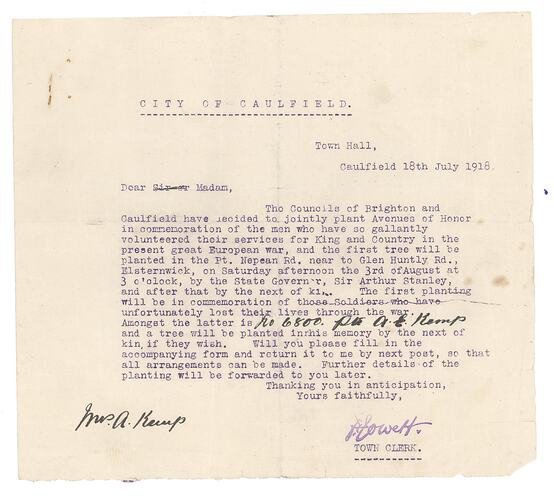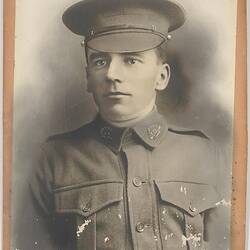Summary
Letter from the City of Caulfield to the widow of Pte Albert Edward Kemp, who was killed in action in 1917. The letter discusses the planting of trees in an Avenue of Honour in memory of World War I soldiers who lost their lives, including Albert Kemp. The Avenue will be planted along what was then "Pt. Nepean Rd" near Glen Huntly Rd, Elsternwick. The tree for Albert is to be planted at 3pm on 3 August, 1918.
The Caulfield Avenue of Honour was located in North Road and Nepean Highway, and was combined with the Brighton Avenue of Honour. The idea was reported in the Argus in July 1918, when it was intended to comprise 'two extensive avenues of gum trees' (Argus, 1 July 1918, p.6). Matters moved fast, and on 3 August the Governor planted the first tree (Argus, 5 August 1918, p.6). On the same day, Albert Kemp's tree was planted.
On 23 August, returned soldiers were invited to muster at Brighton railway station at 2.15, and then march to North Road, accompanied by the bands of the 46th Infantry and Brighton District. The trees were to be planted at the same time on a signal issuing from a raised platform (Argus 22 August 1919, p.6).
Albert's tree was planted in the "third section", listed on page 19 of the Souvenir Programme for the planting. His place of death was listed as France, although he died in Belgium.
Significance
Albert Edward Kemp was a 32-year-old butcher, living at 8 Normanby Ave, Caulfield and married to Annie Josephine, when he enlisted. Born in South Yarra, he was a small man, 5'4½", and weighed only eight stone. He and Annie had a daughter, Ethel Mavis, and a son, George Percival.
Albert enlisted at Royal Park on 4 October 1916, and was assigned to the 22nd Reinforcements, 6th Battalion - regimental number 6800. His battalion left Melbourne 25 October 1916 - just 21 days after Albert enlisted - on the "Ulysses" with two officers and 150 O/Rs. The ship arrived in Plymouth three days after Christmas.
A little over one month later, on 1 February 1917, Albert was disciplined for being absent without leave from midnight and was apprehended the next afternoon. He forfeited 18 days' pay for his offence. He was shipped to France on 27 March, and probably went into action in the trenches. On 13 July Albert was again in trouble, this time for disobeying orders from a superior officer. (It is unclear what his punishment was, but "48 hours" may refer to imprisonment).
Two months later, on 21 September 1917, Albert died in the trenches in Glencorse Wood, Belgium. He is buried at 29 The Ypres (Menin Gate) Memorial, Belgium. His name is located at panel 47 in the Commomorative Area at the Australian War Memorial.
Some time in 1918, Albert's belongings were sent in error to a family who had lost a member by the same name in Wonthaggi, and Annie received that man's belongings. In June she was asked to return the other Pte Kemp's belongings.
Annie received a war pension, but appears to have fallen on hard times - suggested by her need for assistance with a grocery bill approved in one of the documents. She moved to 19 Raleigh St, Malvern in 1922. It is unclear what happened to Ethel, as only George is mentioned from the early 1920s. Further research is required.
The family's home at 8 Normanby Ave is still standing, largely with original façade; their street overall is also largely original.
More Information
-
Collection Names
-
Collecting Areas
-
Acquisition Information
Purchase from Mr Jeff Kemp, 07 Dec 2006
-
Date Made
-
In Memory Of
Private Albert E. Kemp - 6th Battalion, Australian Imperial Force (AIF)
-
Inscriptions
Text: CITY OF CAULFIELD/Town Hall/Caulfield 18th July 1918/Dear Madam,/The Councils of Brighton and/Caulfield have decided to jointly plant Avenues of Honor/in commemoration of the men who have so gallantly/volunteered their services for King and Country in the/present great European war, and the first tree will be/planted in the Pt. Nepean Rd. near to Glen Huntly Rd.,/Elsternwick, on Saturday afternoon the 3rd of August at/ 3 o'clock, by the State Governor, Sir Arthur Stanley,/and after that by the next of kin. The first planting/will be in commemoration of those Soldiers who have/unfortunately lost their lives through the war./Amongst the latter is No 6800 Pte. A.E. Kemp/and a tree will be planted in his memeory by the next of/kin, if they wish. Will you please fill in the/accompanying form and return it to me by next post, so that/all arrangements can be made. Further details of the/planting will be forwarded to you later.
-
Classification
-
Category
-
Discipline
-
Type of item
-
Overall Dimensions
18.8 cm (Length), 20.9 cm (Width)
-
Keywords
Death & Mourning, Wars & Conflicts, World War I, 1914-1918, Making History - Kemp Mourning Collection, Avenues of Honour


